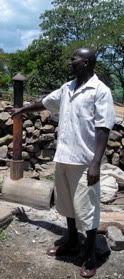Self Sustaining Children’s Home
 Dr Erick Owino Otieno
Dr Erick Owino OtienoWe have an opportunity to dramatically change the lives of many orphans in Kenya and the entire Lake Victoria Region of East Africa through the development of a Self Sustaining Children’s Home. The idea of the Self Sustaining Children’s Home (SSCH hereafter) came to Dr. Erick Otieno when he noticed that children were not being cared for as they had been in the past, resulting primarily from the breakdown of the system of polygamy within Kenyan society.
As the AIDS pandemic continues at an alarming rate to produce more and more orphaned children, Dr. Otieno had the idea of creating the SSCH with sustainable functions to provide long term care and assistance for these many orphans. His ideas include self sustaining resources that actually produce a surplus of funding that is re-directed back into the home. Not only does the SSCH care for the children, but long-term plans for each child include a cash fund for when they leave the home to start a life as an adult.
Some of the sustainable features of the home include Methane Gas production, cash crops, and the raising of cows and chickens. Dr. Otieno was introduced to Methane Gas production during his professional training and worked with a larger unit at an industrial farm facility where he was employed as a Veterinarian.
 Hen House
Hen HouseThe dairy cow is a key element to the success of the SSCH. The cow produces all of the dung for the methane plant as well as milk to be sold at the market in order to fund the SSCH expenses. A small methane gas unit costing Kshs 100,000 would be used for providing all the gas for cooking and lighting a smaller application, such as a home. The methane plant works by producing gas from dung from farm animals (cows) placed in the plant daily. The methane plant is sustainable in two ways: it eliminates the need to pay for electricity, and it prevents further depleting forest reserves because people currently use charcoal for cooking.
Chickens will also be raised to provide eggs for food for the SSCH community, and any excess eggs will be sold in the market to supplement the income. Cash crops will be grown to provide for the nutritional needs of the children and also establish another income source to the SSCH.
Why is this project important?
Potential Long Term Impact: Once we have success with this project in Kenya we can take the “frame work” and apply this model in other countries. Orphans in countries like Uganda, Tanzania, Rwanda, Burundi, and the Congo DRC would benefit greatly from projects like this!
Where will this project be implemented?
The project will be located in Uranga Division in Siaya district, Nyanza province, Kenya, East Africa, which has a population of 60,000 people.
Poverty prevalence is 56%, HIV/Aids prevalence is 6.7%
Uranga is 1000-1300m above sea level, with an annual rainfall of 1000-1200 mm, and average temperature 21.4-22.3C.
Who is on the team?
- Dr Erick Owino Otieno
- James Opiyo
- Gorrety Amollo
- Millicent Akinyi Otieno
- Ed Markiewicz
- Marty Miller
- Vonda Winkle
- Joe Provence
- Kaaren Provence
- Cindy Womack
Help Build A Self Sustaining Children’s Home!
Missing Persons Awareness and Support Network
http://peace4missing.ning.com







1 comment:
Please Visit: http://kutumaini.com/self-sustaining-childrens-home/
for the original posting and video!
Thanks
Joe
Post a Comment